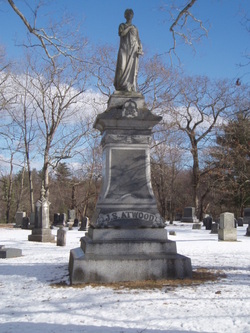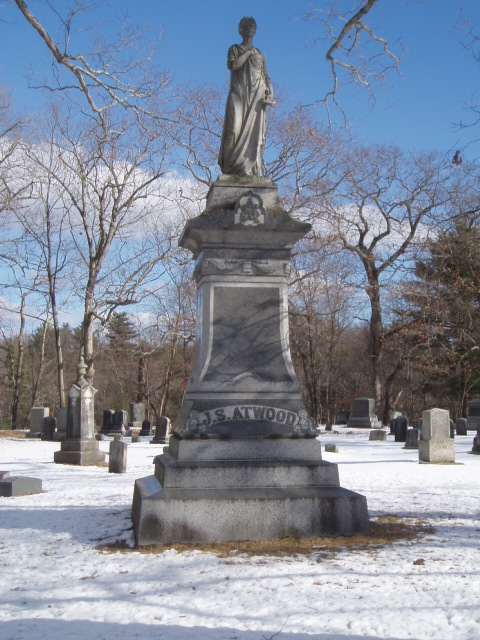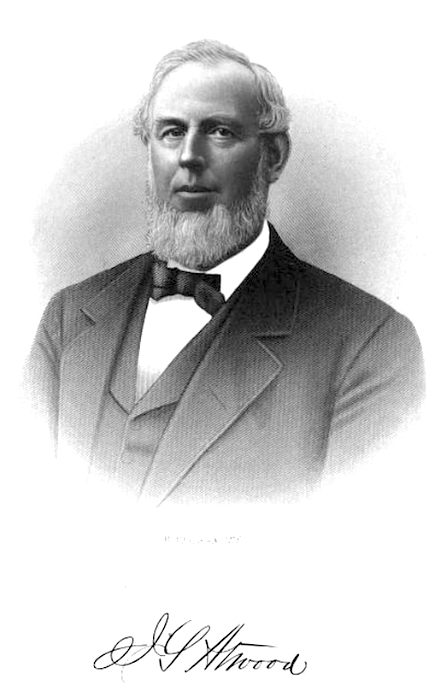“JAMES S. ATWOOD, son of John, and father of J. Arthur and J. Walter, was born in Scituate, R. I., March 17, 1832, and died Feb. 20, 1885, at Wauregan, Conn. After receiving a liberal education, at Smithville Seminary, in Scituate, and Woodstock Academy, in Woodstock, he entered his father’s cotton mill in Williamsville, town of Killingly, and there mastered every detail of cotton manufacturing, serving in the various positions from bobbin-boy to general manager, and thus making himself perfectly familiar with the construction and working of every machine in the mill.
“On Sept. 17, 1855, Mr. Atwood married Julia A. M. Haskell… The family born to this marriage consisted of three sons, namely: William Hamilton, who was born Nov. 8, 1859, and died Jan. 18, 1862; and James Arthur and John Walter, twins, born May 18, 1864.
“In 1853 James S. Atwood became connected with the mill interests at Wauregan, Conn. The mill privilege at this point was purchased by A. D. Loockwood and others, and in 1853–54 a structure 253 feet in length and 49 feet in width, three stories in height, was erected for the manufacture of plain and fancy cotton cloth. Business became so prosperous that in 1858–59 the length of the building was doubled, and in 1866–67 a new building, 500 feet in length, and four stories high, was built on the other side of the trench, and the two parallel buildings were connected in the middle by a building 167 feet long, extending across from one to the other. This made a total length in three parts of about 1,250 feet. This great factory is built of rough stone, quarried in the vicinity. Water from the Quinebaug is carried through five turbine wheels, giving what is estimated as equal to 1,050 horse-power. In addition the building contains two steam engines of 750 horse-power, which are made use of as occasion requires.
“At the opening of the mills Mr. Lockwood was agent, but he soon afterward disposed of his interests, and Mr. Atwood, who had been superintendent from the start, was made agent, and remained in that position until his death. The financial success of this great industry can be directly traced to the supervision of James S. Atwood, who was there when the first machine was put in place, and witnessed the business expand to its present magnitude. Although Mr. Atwood was financially interested in mills at Williamsville and at Taftville, he always made his home in Wauregan. He took great pride in the village which he saw, under the fostering care and ownership of the company, develop into one of the model hamlets of the vicinity, where the employes could find attractive and comfortable homes near their daily tasks, and lived to see the newly planted trees expand their limbs and foliage until they almost screened the great mill from sight.
“The large concern known as the Poneman Mills, at Taftville, Conn., was an enterprise in which he also took pride, and in which his managing hand was very evident. It was built after his own plan and under his direct supervision, and, like the business at Wauregan, enjoyed phenomenal success. At this time the manufacture of the fine goods turned out by these mills was in the nature of an experiment, and it was largely owing to Mr. Atwood’s good judgment, careful oversight and ability to adapt means to the desired ends that success crowned the work. Of these mills he was agent from the beginning until his death. His judgment was reliable, and he was not one to risk the money of the corporations he represented in any foolish experiments. During one of the changes which are liable to occur in business enterprises in this country, it became necessary for him to assume control of the mills at Williamsville, in which he and his brother William A. were largely interested, and his financial credit and wise judgment carried them through difficulties that might have proven disastrous in less careful hands….
“In political life Mr. Atwood was identified with the Republican party, and he was a useful member of the State Legislature in 1862 and again in 1868, and a Presidential elector (on the Republican ticket) in the campaign of 1884. While Mr. Atwood was acknowledged to be the peer of practical manufacturers and the possessor of large means, he was a man of most simple tastes, without the shadow of a desire for display, on the other hand always hiding his ability, with a modestry which was as rare as it was commendable. While he despised shams and hollow pretense, he was kind in judgment, tolerant of the imperfections of others, ready to overlook mistakes, and ever ready to see in every man a friend and brother. Upon his open countenance he bore the stamp of true worth, and no one feared to trust him implicitly. The poorest and humblest member of the community could always approach James S. Atwood with the assurance that he would receive the same respectful attention which would be accorded one possessing high position or great wealth. His heart throbbed in sympathy with the sorrowing and the suffering, and his hand was ever open in relief. No one will ever know the extent of his benevolences. Irreproachable in character, gentlemanly in bearing toward every individual, it was no wonder that every one with whom he came into contact felt that he could say, ‘He is my friend.’…
“It was through Mr. Atwood’s efforts that the Congregational Church in Wauregan was erected, a structure which is a gem of architectural beauty and a fitting memorial of one who sought not alone his own but also his neighbor’s welfare and happiness….”
—Commemorative Biographical Record of Tolland and Windham Counties Connecticut Containing Biographical Sketches of Prominent and Representative Citizens and of Many of the Early Settled Families, Chicago: J. H. Beers, 1903, pp. 72–73.
“JAMES S. ATWOOD, son of John, and father of J. Arthur and J. Walter, was born in Scituate, R. I., March 17, 1832, and died Feb. 20, 1885, at Wauregan, Conn. After receiving a liberal education, at Smithville Seminary, in Scituate, and Woodstock Academy, in Woodstock, he entered his father’s cotton mill in Williamsville, town of Killingly, and there mastered every detail of cotton manufacturing, serving in the various positions from bobbin-boy to general manager, and thus making himself perfectly familiar with the construction and working of every machine in the mill.
“On Sept. 17, 1855, Mr. Atwood married Julia A. M. Haskell… The family born to this marriage consisted of three sons, namely: William Hamilton, who was born Nov. 8, 1859, and died Jan. 18, 1862; and James Arthur and John Walter, twins, born May 18, 1864.
“In 1853 James S. Atwood became connected with the mill interests at Wauregan, Conn. The mill privilege at this point was purchased by A. D. Loockwood and others, and in 1853–54 a structure 253 feet in length and 49 feet in width, three stories in height, was erected for the manufacture of plain and fancy cotton cloth. Business became so prosperous that in 1858–59 the length of the building was doubled, and in 1866–67 a new building, 500 feet in length, and four stories high, was built on the other side of the trench, and the two parallel buildings were connected in the middle by a building 167 feet long, extending across from one to the other. This made a total length in three parts of about 1,250 feet. This great factory is built of rough stone, quarried in the vicinity. Water from the Quinebaug is carried through five turbine wheels, giving what is estimated as equal to 1,050 horse-power. In addition the building contains two steam engines of 750 horse-power, which are made use of as occasion requires.
“At the opening of the mills Mr. Lockwood was agent, but he soon afterward disposed of his interests, and Mr. Atwood, who had been superintendent from the start, was made agent, and remained in that position until his death. The financial success of this great industry can be directly traced to the supervision of James S. Atwood, who was there when the first machine was put in place, and witnessed the business expand to its present magnitude. Although Mr. Atwood was financially interested in mills at Williamsville and at Taftville, he always made his home in Wauregan. He took great pride in the village which he saw, under the fostering care and ownership of the company, develop into one of the model hamlets of the vicinity, where the employes could find attractive and comfortable homes near their daily tasks, and lived to see the newly planted trees expand their limbs and foliage until they almost screened the great mill from sight.
“The large concern known as the Poneman Mills, at Taftville, Conn., was an enterprise in which he also took pride, and in which his managing hand was very evident. It was built after his own plan and under his direct supervision, and, like the business at Wauregan, enjoyed phenomenal success. At this time the manufacture of the fine goods turned out by these mills was in the nature of an experiment, and it was largely owing to Mr. Atwood’s good judgment, careful oversight and ability to adapt means to the desired ends that success crowned the work. Of these mills he was agent from the beginning until his death. His judgment was reliable, and he was not one to risk the money of the corporations he represented in any foolish experiments. During one of the changes which are liable to occur in business enterprises in this country, it became necessary for him to assume control of the mills at Williamsville, in which he and his brother William A. were largely interested, and his financial credit and wise judgment carried them through difficulties that might have proven disastrous in less careful hands….
“In political life Mr. Atwood was identified with the Republican party, and he was a useful member of the State Legislature in 1862 and again in 1868, and a Presidential elector (on the Republican ticket) in the campaign of 1884. While Mr. Atwood was acknowledged to be the peer of practical manufacturers and the possessor of large means, he was a man of most simple tastes, without the shadow of a desire for display, on the other hand always hiding his ability, with a modestry which was as rare as it was commendable. While he despised shams and hollow pretense, he was kind in judgment, tolerant of the imperfections of others, ready to overlook mistakes, and ever ready to see in every man a friend and brother. Upon his open countenance he bore the stamp of true worth, and no one feared to trust him implicitly. The poorest and humblest member of the community could always approach James S. Atwood with the assurance that he would receive the same respectful attention which would be accorded one possessing high position or great wealth. His heart throbbed in sympathy with the sorrowing and the suffering, and his hand was ever open in relief. No one will ever know the extent of his benevolences. Irreproachable in character, gentlemanly in bearing toward every individual, it was no wonder that every one with whom he came into contact felt that he could say, ‘He is my friend.’…
“It was through Mr. Atwood’s efforts that the Congregational Church in Wauregan was erected, a structure which is a gem of architectural beauty and a fitting memorial of one who sought not alone his own but also his neighbor’s welfare and happiness….”
—Commemorative Biographical Record of Tolland and Windham Counties Connecticut Containing Biographical Sketches of Prominent and Representative Citizens and of Many of the Early Settled Families, Chicago: J. H. Beers, 1903, pp. 72–73.
Family Members
Advertisement
Advertisement











